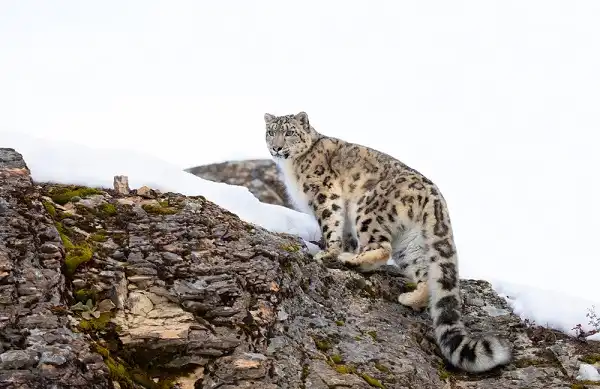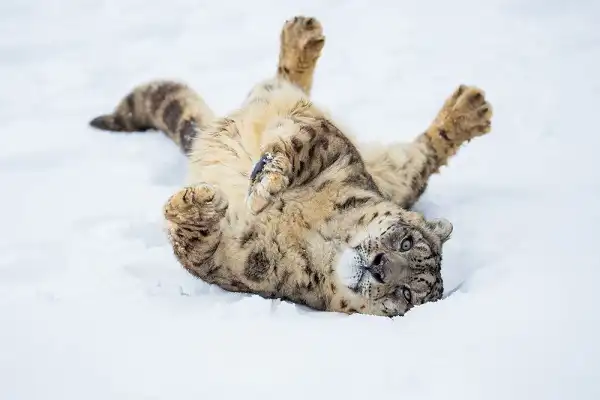The snow leopard is one of the rarest and most elusive animals in the world—a true marvel of nature. It inhabits remote mountain regions, where it hunts wild goats, sheep, and other prey for survival. With its thick fur coat against the cold winters at high elevations, this big cat adapts to life in some of the harshest conditions on Earth. As if that wasn’t enough to make this animal fascinating on its own, there’s still much that we don’t know about them! We have so much to learn about their behavior and ecology as they remain so rarely seen. In this blog post, you’ll find out everything you need to know about these mysterious creatures, from what they look like, how they live their lives, and what threats face them today—explore with us now!

Snow Leopard Description
The snow leopard is a large and powerful feline. This big cat is identified by its thick, long fur coat that can be grey or white in color with black spots throughout—a pattern unique to the species. Their long, black-tipped tails make them even more recognizable. The snow leopard has strong legs and broad paws which have fur on the soles for added insulation against the cold ground and for better grip when climbing steep terrain. The snow leopard has adapted to survive in some of the harshest environments on Earth. Its short muzzle helps prevent heat loss while its wide ears help it detect prey over long distances. It also has a specially adapted heart rate which slows down during periods of rest—allowing it to save energy and preserve body heat until active hunting resumes again.
Snow Leopard Habitat
The snow leopard can be found in high mountain regions spanning from Central Asia to parts of India, Pakistan, Nepal, Bhutan, China, Russia, Mongolia, and Afghanistan. They dwell in steep terrain with elevations ranging from 2000 to 6000 meters above sea level and seek out rocky crags for shelter. The terrain is often craggy but also features rocky riverbeds and grassy meadows. Snow leopards generally prefer snow-covered slopes with plenty of boulders for cover against prey and predators alike. Temperatures in these habitats range from -40 degrees Celsius (-40 Fahrenheit) during the winter months to 20 degrees Celsius (68 Fahrenheit) during the summer months—adaptations have enabled them to cope with such extreme conditions. Snow leopards are also known to inhabit alpine scrubland and open woodlands featuring juniper trees where they find food sources such as wild goats, sheep, marmots, hares, and pikas. They tend to avoid dense forests due to a lack of suitable prey and difficulty in stalking targets.
Snow Leopard Diet
The snow leopard’s diet consists mostly of wild goats, sheep, marmots, hares, and pikas. They mainly hunt at night or twilight when their prey is most active and the cover of darkness gives them a tactical advantage. When stalking their prey, these cats use their excellent hearing and vision to detect movement in the shadows. When they catch their quarry, they use their powerful claws and teeth to finish it off quickly. They also scavenge carrion from time to time for an easy meal. Snow leopards have evolved an interesting adaptation that allows them to survive in such cold climates—they are able to increase the amount of fat stored in their bodies during times of abundance which provides much-needed sustenance during winter months when food may be scarce. This adaptation has likely been essential for the success of this species and its ability to thrive in such extreme conditions.

Snow Leopard Size
The snow leopard is a large and powerful feline, weighing an average of 75 to 105 lbs. It has long legs and broad paws with fur on the sole for better grip when climbing steep terrain. Its thick coat helps keep it warm in temperatures down to -40 degrees Celsius (or -40 Fahrenheit). Meanwhile, its tail can reach up to 35 inches and is tipped with black fur. The snow leopard’s head-to-body size averages 3 feet 6 inches, while its shoulder height can range from 22-30 inches. Adult males typically weigh more than adult females. The snow leopard’s size makes it ideal for surviving in some of the harshest environments on Earth. Its thick fur coat provides insulation against extreme temperatures while its long legs enable it to jump great distances to catch prey or escape predators. The combination of an agile build and powerful muscles means that the snow leopard can climb steep terrain quickly and easily despite its bulky size.
Snow Leopard Lifespan
Snow Leopards typically have a lifespan of between 10 and 15 years in the wild, although they may live longer in captivity. They reach sexual maturity between 2 and 3 years old and can reproduce up to 5 times during their lifetime. The survival of cubs is heavily dependent on the availability of prey. If food is scarce, cubs are more likely to starve or be killed by predators. As adults, Snow Leopards face many threats including human persecution, habitat destruction, poaching, and competition with livestock for food. In spite of these challenges, Snow Leopards tend to live long lives if they are able to reach adulthood. They are generally solitary animals who do not form social bonds with other cats outside of mating season.
Male and female Snow Leopards live apart from each other throughout the year except for a few weeks when they mate. The male will then leave after the mating period and will not raise the young cubs himself. The snow leopard’s life expectancy can be affected by various factors such as diet, disease, weather conditions, and predation. It is estimated that only 20% of cubs survive their first year—meaning that four out of five cubs may not make it past their first birthday! In addition to natural threats, human activity has also contributed significantly to the decline in snow leopard numbers in recent years due to habitat destruction and poaching.
Snow Leopard Behavior
Snow leopards are solitary animals who form social bonds only during mating season. They are mostly active at night or twilight when their prey is most active and they have a tactical advantage due to the cover of darkness. Using their excellent hearing and vision, they can detect movement in the shadows and quickly finish off their quarry with powerful claws and teeth. They may also scavenge carrion for an easy meal from time to time. Snow leopards also exhibit territorial behavior; males will spray urine around the borders of their territories while females will scratch trees as a sign of dominance. Both sexes will vocalize during mating season with low-frequency calls known as chuffing; these calls serve to establish contact between individuals and can even be heard up to a kilometer away!

Snow Leopard Speed
Snow Leopards are incredibly agile and powerful cats that can reach speeds of up to 37 mph. Their long legs enable them to jump great distances, while their muscular build and large paws help them climb steep terrain quickly. This combination of physical characteristics allows the Snow Leopard to navigate both flat and rugged landscapes with ease. The species’ adaptability also enhances their speed; they can adjust to different environments such as rocky riverbeds, grassy meadows, alpine scrubland, and open woodlands featuring juniper trees. This gives them a wide range of potential habitats in which they can hunt for food sources such as wild goats, sheep, marmots, hares, and pikas – all depending on the availability of resources in their area. In addition to speed, Snow Leopards possess great dexterity; they are able to rotate their hind feet 180 degrees so that they land on the front side of their paw when leaping from a vertical surface—such as a tree—enabling them to better control their descent and avoid injury upon landing.
Snow Leopard Hunting
Snow Leopards are excellent hunters, capable of taking down prey much bigger than themselves. They primarily hunt wild goats, sheep, marmots, hares, and pikas that inhabit their mountainous terrain. To achieve this, they use their keen sense of hearing and vision to spot potential prey from a distance. When hunting larger animals such as sheep or goats, Snow Leopards employ a technique known as “stalk-and-pounce” where they will stealthily approach the animal before pouncing onto it with powerful claws and teeth. Smaller animals like marmots are often tackled with one dramatic leap; the cat can reach speeds of up to 37 mph in pursuit! If their initial attack is unsuccessful, Snow Leopards will typically retreat to an area with better cover and wait for another opportunity. However, if they succeed in killing their target, they will take it back to a safe place—such as a rocky ledge or hidden alcove—where they can eat without interruption from predators or scavengers.
Snow Leopard Reproduction
Snow Leopards reproduce by mating with a partner during the winter months. During this time, males will search for females in their territory by calling out with low-frequency calls known as “chuffing”. Females who are ready to mate will respond with a chuff of their own, allowing the male to locate her and begin the mating process. After successful fertilization has occurred, the female Snow Leopard will enter into a gestation period that typically lasts around 3 and a half months. Mothers give birth to litters of 1 to 5 cubs usually in April or May, in an undisclosed den which is often surrounded by rocky outcrops for added protection from potential threats. The cubs are born blind and helpless; however, over time they start to grow rapidly due to their mother’s milk and receive additional nourishment through small prey that she hunts for them. They develop their strength slowly over the following months as they begin to explore and learn how to hunt on their own. By 8 months of age, cubs have usually become independent enough to venture off on their own; though they may remain within their parents’ territory until adulthood when they will eventually move away in order to find a mate and establish their own home range.

Conclusion
The Snow Leopard is a remarkable species that has adapted to survive in the harsh conditions of its mountainous home. Their physical characteristics such as speed, agility, and strength help them hunt for food sources while their thick fur ensures they remain comfortable in extreme temperatures. Sadly though, human activities have put immense pressure on this species leading to sharp declines in population numbers worldwide—highlighting the importance of conservation efforts now more than ever! With proper protection from humans along with improved regulations on hunting practices, we may be able to ensure that future generations of these cats have a chance at surviving in the wild for many years to come.
Frequently Asked Question


